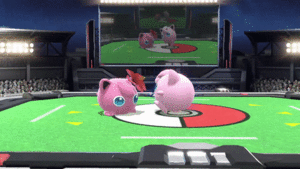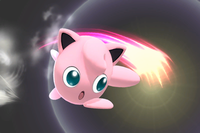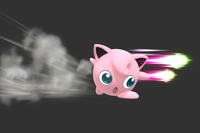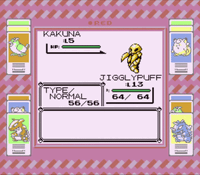| Welcome to SmashWiki! Log in or create an account and join the community, and don't forget to read this first! |
| Notices |
|---|
| The Skill parameter has been removed from Smasher infoboxes, and in its place are the new "Best historical ranking" and "Best tournament result" parameters. SmashWiki needs help adding these new parameters to Smasher infoboxes, refer to the guidelines here for what should be included in these new parameters. |
| When adding results to Smasher pages, include each tournament's entrant number in addition to the player's placement, and use the {{Trn}} template with the matching game specified. Please also fix old results on Smasher pages that do not abide to this standard. Refer to our Smasher article guidelines to see how results tables should be formatted. |
| Check out our project page for ongoing projects that SmashWiki needs help with. |
Pound: Difference between revisions
m (→Trivia: SmashPedia link) |
JUSTplayIN (talk | contribs) m (→Overview: changed “she” to “it”) Tag: Mobile edit |
||
| Line 26: | Line 26: | ||
===Rising Pound=== | ===Rising Pound=== | ||
[[File:Rising Pound.gif|thumb|Pound performed repeatedly in ''Melee''. Note how Jigglypuff travels a large horizontal distance while losing almost no height and using no jumps.]] | [[File:Rising Pound.gif|thumb|Pound performed repeatedly in ''Melee''. Note how Jigglypuff travels a large horizontal distance while losing almost no height and using no jumps.]] | ||
As pressing up quickly after using Pound causes Jigglypuff to gain height, and the move does not put it into [[helpless]] state, Pound gives Jigglypuff a gigantic horizontal recovery. This technique is known as a "rising Pound". Contrary to popular belief, this is not infinite, as the ending lag causes Jigglypuff to end up slightly lower than its original position. However, it still gives it a great advantage in stalling, being able to go under many stages and go to the other side. In all games except ''SSB'' and ''SSB4'', this technique actually bolsters Jigglypuff's vertical recovery if | As pressing up quickly after using Pound causes Jigglypuff to gain height, and the move does not put it into [[helpless]] state, Pound gives Jigglypuff a gigantic horizontal recovery. This technique is known as a "rising Pound". Contrary to popular belief, this is not infinite, as the ending lag causes Jigglypuff to end up slightly lower than its original position. However, it still gives it a great advantage in stalling, being able to go under many stages and go to the other side. In all games except ''SSB'' and ''SSB4'', this technique actually bolsters Jigglypuff's vertical recovery if it uses a rising Pound after each jump. | ||
It is also possible to perform a "falling Pound" by pressing down instead of up after using Pound, which instead moves Jigglypuff slightly downwards. | It is also possible to perform a "falling Pound" by pressing down instead of up after using Pound, which instead moves Jigglypuff slightly downwards. | ||
Revision as of 05:23, March 18, 2024
| Pound | |
|---|---|
 Pound being used in Super Smash Bros. Ultimate. | |
| User | Jigglypuff |
| Universe | Pokémon |
| Article on Bulbapedia | Pound (move) |
Pound (はたく, Strike) is Jigglypuff's neutral special move in Super Smash Bros. and side special move from Super Smash Bros. Melee onward.
Overview
Pound is a quick, short-ranged punch that sends Jigglypuff forward a short distance. While using the move, Jigglypuff will vocalize "Puff!" with its arm out in front of it while punching. Pound is very useful when recovering, as it can be used between jumps to give Jigglypuff more horizontal distance. This technique is required to beat Jigglypuff's Board the Platforms in Super Smash Bros.
While useful for mobility, Pound also has offensive uses due to its sex kick properties and high shield damage. Due to its lingering hitbox, Pound stays out longer than one might expect, which often causes opponents to drop their guard too early at times. In certain situations, this can serve as a set-up for Jigglypuff's powerful Rest attack. Its usefulness against shields is particularly useful due to Jigglypuff's constant aerial playstyle, and can punish opponents who overuse shields in an attempt to punish Jigglypuff out of shield. In Super Smash Bros. 4, Pound significantly benefits from the removal of damage reduction on shields, allowing it to pop shields with less than 70% health, a technique which was further improved in Super Smash Bros. Ultimate.
In the original, the move always launched opponents at a diagonal angle behind Jigglypuff. In Melee, Pound either knocks opponents vertically if used at a close range, or sends them at a slightly more horizontal angle than in the original game if it hits afterwards, while in Super Smash Bros. Brawl onwards, the angles are the opposite of Melee. The move does a maximum of 13% damage in the original and Melee, and 11% since Brawl.
In Ultimate, this move has reduced ending lag and an improved hitstun modifier, giving it exceptional combo potential into all of Jigglypuff's aerials and Rest. It also has improved shield pressure capabilities and a larger hitbox when airborne, making it overall an extremely useful neutral option and one of Jigglypuff's better moves overall.
Rising Pound
As pressing up quickly after using Pound causes Jigglypuff to gain height, and the move does not put it into helpless state, Pound gives Jigglypuff a gigantic horizontal recovery. This technique is known as a "rising Pound". Contrary to popular belief, this is not infinite, as the ending lag causes Jigglypuff to end up slightly lower than its original position. However, it still gives it a great advantage in stalling, being able to go under many stages and go to the other side. In all games except SSB and SSB4, this technique actually bolsters Jigglypuff's vertical recovery if it uses a rising Pound after each jump.
It is also possible to perform a "falling Pound" by pressing down instead of up after using Pound, which instead moves Jigglypuff slightly downwards.
In SSB, Pound has more ending lag than in the later games, making the technique less effective and harder to utilize. However, as it is Jigglypuff's neutral special in this game, Kirby can copy the move and use this same technique, giving him a better recovery as he can use Final Cutter for additional height. In Brawl and Smash 4, after using all of Jigglypuff's midair jumps, CPUs use this move repeatedly until they recover, or are eventually KO'd.
In Smash 4, Pound has lost some of its horizontal distance, limiting its recovery abilities. However, in Ultimate this is somewhat compensated by a reduction to the move's ending lag, meaning that while it is still a less effective recovery than in Melee and Brawl and consecutive Pounds to recover are borderline ineffectual due to further nerfs to the move's momentum, Rising Pound is once again a notable tactic for boosting Jigglypuff's recovery.
Instructional quotes
| Pound does serious damage, and it can also help as a recovery move. | ||
| Slap your opponents so hard they fly straight into the air. | ||
| Steps forward and slaps opponents so hard they fly straight into the air. |
Customization
Special Move customization was added in Super Smash Bros. 4. These are the variations:
| 1. Pound | 2. Sideways Pound | 3. Pound Blitz |
|---|---|---|
| "Step forward and slap your opponents so hard they fly straight into the air." | "Slap opponents, and launch them sideways." | "A lunging strike that sends you sliding across the ground. Can hit multiple times." |
- Pound: Default.
- Sideways Pound: A somewhat altered version of Pound. The startup and ending lag is increased somewhat, and the move does less damage (11% -> 7%) and shield damage (20 -> 10 ground, 0 air), while also negating Jigglypuff's momentum almost entirely with none at all for the aerial version. However, the move is now a semi-spike, improving its edgeguarding and gimping potential.
- Pound Blitz: The Pound is now a multi-hit. Additionally, Jigglypuff slides further while using the move, and it has a larger hitbox, improving its usage for recovery and significantly boosting its range. However, it deals slightly less damage if all hits connect, is less effective on shields and has noticeably increased startup and ending lag, making it somewhat of a commitment, as well as less safe.
Origin
Introduced in Generation I, Pound is a physical Normal-type attack that is learned at start or at a low level by many Pokémon, similar to both Tackle and Scratch. Due to its very low base power and the existence of superior Normal-type attacks, players as a result will typically replace Pound with more powerful and effective moves that their Pokémon learn later as they level up. Jigglypuff can learn it at a very low level in all generations; in Pokémon Red, it learns it at level 9. Pound is the first move in the series's move index, implying it was the first move ever made.
Gallery
Pound in Super Smash Bros. for Nintendo 3DS.
Pound in Super Smash Bros. for Wii U.
Names in other languages
| Language | Name |
|---|---|
| はたく | |
| Pound | |
| Écras'Face | |
| Pfund | |
| Destructor | |
| Botta | |
| 拍击 | |
| 拍擊 | |
| 막치기 | |
| Dreun | |
| Тяжёлый Удар |
Trivia
- Pound is one of three neutral special moves in Smash 64 to be a side special in Melee, and one of six moves to have its directional input changed throughout the series. The other five are PK Fire, Boomerang, Rock Smash, Reflect Barrier and Explosive Flame.
- Of the three neutral special moves that became side special moves from the jump to Super Smash Bros. Melee, Pound is the only one that isn't a projectile.
- Prior to Smash 4, this is Jigglypuff's only special move where it doesn't face the screen when performed while facing left.












